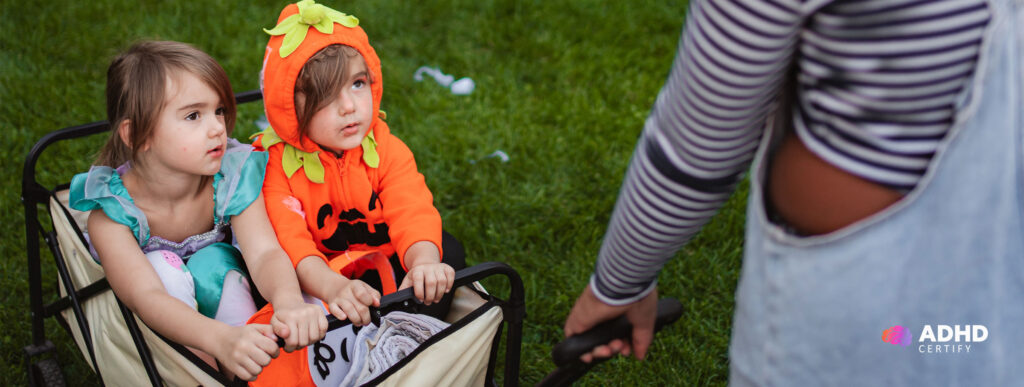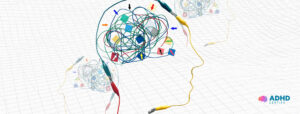Halloween can be exciting, but for people with ADHD, it often comes with a hidden cost. Bright lights, loud noises, sugar spikes and unpredictable social settings can quickly lead to sensory overload, impulsivity and stress. Disrupted routines or late bedtimes only add to the pressure.
If you’re wondering whether it’s possible to enjoy the night without all the overwhelm, the answer is yes. With a few tailored adjustments, you can shape a more relaxed and joyful evening.
An ADHD-friendly Halloween isn’t about opting out; it’s about doing what works best for you or your family.
In England, an estimated 2,498,000 people are living with ADHD, including those without a formal diagnosis. Of these, 741,000 are children and young people aged 5 to 24. This data comes from the ADHD Management Information – May 2025 release, published by NHS England and NHS Digital on 29 May 2025.
Key Takeaways
- Understanding the ADHD Experience at Halloween
Learn why costumes, sugar, noise and unpredictability can overwhelm ADHD brains of all ages. - Planning Ahead for a Calmer Halloween
Visual plans, realistic expectations and routine support help reduce stress before, during and after events. - Sensory-Friendly and Inclusive Halloween Ideas
Soft costumes, quiet corners and alternative events create safer, more enjoyable experiences for neurodivergent families. - Supporting ADHD Adults During Seasonal Changes
Use light therapy, structured routines and gentle socialising to manage energy and seasonal mood shifts. - Encouraging Empathy and Inclusion
Model neurodiversity awareness with kids and create events that welcome everyone, not just the majority.
Now let’s look at how Halloween and ADHD interact, and why understanding the experience is the first step towards inclusion.
Understanding the ADHD Experience at Halloween
For many, Halloween brings excitement, but for those with ADHD, it can also mean overstimulation, impulsivity and sensory stress. What’s meant to be fun and festive can feel chaotic. The clash of costumes, crowds and sugar highs creates a perfect storm for overwhelm, especially for families trying to enjoy an ADHD-friendly Halloween.
Why Halloween Can Be Challenging
- Overstimulation is a big one. Costumes that itch, lights that flash and loud, unexpected sounds can throw off the entire evening.
- Disrupted routines affect focus and behaviour. Extra sugar, late bedtimes and skipped meals can lead to emotional spikes and crashes.
- Unpredictability makes self-regulation tough. Last-minute changes and social surprises are common triggers in the mix of Halloween and ADHD.
Recognising Different Needs
ADHD shows up differently in adults and children. Some might thrive in small, structured activities, while others may prefer staying home altogether.
Open communication and self-awareness help shape inclusive Halloween tips that reflect your family’s reality. Whether it’s a costume-free party or trick-or-treating with noise-cancelling headphones, adjusting plans doesn’t mean missing out; it means showing up in a way that works.
Planning Ahead for a Calmer Halloween
A little structure can be the difference between chaos and connection. For both kids and adults, a bit of forethought turns potential stress into something joyful, especially when you’re planning a calm Halloween idea that actually suits ADHD brains.
Simplify the Schedule
- Use a visual or written plan to lay out times, locations and snacks.
- Avoid crowding the calendar with too many events. This is one of the best Halloween tips for parents with ADHD children who may get overwhelmed easily.
- Build in transition time. Rushing only adds stress.
Set Realistic Expectations
- Focus on one or two meaningful activities instead of cramming everything in.
- Talk about the plan ahead of time to avoid last-minute anxiety or meltdowns.
If you’re unsure whether your child is experiencing overwhelm, our guide on ADHD Shutdown vs Meltdown explains the signs and offers practical support strategies.
Support Transitions and Routines
- Stick to usual mealtimes and bedtime routines as much as possible.
- Plan a buffer after Halloween to allow everyone to decompress, soft clothes, quiet time, familiar comfort items. For ADHD adults facing seasonal changes, this kind of downtime is especially helpful.
These sensory-friendly Halloween strategies give everyone space to enjoy the night their way with fewer meltdowns and more memories.
Sensory-Friendly and Inclusive Halloween Ideas
Small adjustments can make big differences in how children and adults with ADHD experience the night. The goal isn’t perfection, it’s comfort. When you build in choice, predictability and sensory safety, you’re creating space for everyone to enjoy Halloween on their own terms.
These inclusive Halloween tips can help make the season feel fun, not fraught.
Costumes That Feel Comfortable
- Choose soft, breathable fabrics and familiar outfits to avoid itchiness, tightness or overheating.
- Skip rigid costumes with masks or tags. Instead, try themed pyjamas, sporty outfits, or DIY looks based on clothes your child already loves.
- For adults, comfort-first styling matters too. Think layers, loose fits or even non-costume participation if that feels best; this is your ADHD-friendly Halloween.
Trick-or-Treating Alternatives
- Look for community centres or local events offering calmer environments, especially indoors. These are ideal for kids who find the unpredictability of door-to-door visits overwhelming.
- Bring along noise-cancelling headphones or ear defenders if your child (or you) are sensitive to loud crowds.
- Go early to avoid peak traffic. Many UK communities offer early access sessions that work well for sensory-friendly Halloween celebrations.
Create a Safe Home Base
- Set up a quiet, cosy space at home for when things get too much; soft lighting, snacks, headphones or sensory toys work wonders.
- Offer an inclusive, low-sugar treat bowl for visitors. This helps kids with dietary needs (or sugar-sensitive ADHD moods) feel seen and included.
Bonus tip:
Let neighbours know in advance if you’re planning a quiet household. A teal pumpkin on the doorstep signals you’re offering inclusive Halloween tips in action.
Supporting ADHD Adults During Seasonal Changes
As routines shift with darker evenings and colder weather, adults with ADHD can also find this time of year more challenging. It’s not just about the kids in costumes. Grown-ups with ADHD often feel the pull of seasonal change more deeply than they let on. Reduced daylight, disrupted routines and back-to-back social events can affect focus, sleep and emotional regulation.
Managing Energy and Seasonal Mood Changes
- Autumn and winter can worsen symptoms of seasonal affective disorder (SAD). Fewer daylight hours may impact motivation and mood.
- Try light therapy boxes, even short morning walks or keeping lights bright indoors. These can help maintain energy and structure.
- Plan consistent evening activities to add shape to the week. Reading groups, crafting nights or exercise classes can anchor the season.
Staying Connected and Balanced
- ADHD can feel isolating, especially when energy dips. Choose mindful, low-pressure gatherings that don’t require full-on social performance.
- Use digital tools to your advantage. Set reminders for sleep routines, quiet evenings, and even post-event downtime. These habits help manage the seasonal changes (especially for ADHD adults) that often go unnoticed.
Encouraging Empathy and Inclusion
Halloween is about community and fun, and small acts of understanding can help everyone feel included. Whether you’re parenting a neurodivergent child or navigating ADHD as an adult, the power of small, intentional choices makes all the difference.
How Families Can Model Inclusion
- Teach children that not everyone enjoys loud noises, jump scares or sugar overload. Respecting someone’s boundaries is part of the fun.
- Use Halloween to introduce the idea of neurodiversity. A quick chat about why a friend prefers quiet or skips costumes can build empathy naturally.
These inclusive Halloween tips help shape a generation that knows difference is not just normal, but valuable.
Building Inclusive Community Events
- Support or organise teal pumpkin initiatives that offer allergy-safe or non-food treats. They’re simple, visible ways to promote inclusion.
- Connect with schools, parenting groups or local libraries to suggest sensory-friendly Halloween hours or alternative activities. These efforts make the night accessible to more families without taking away the fun.
Conclusion
A successful ADHD-friendly Halloween starts with empathy, flexibility and simple planning. Whether you’re managing overstimulation, shifting routines or just trying to keep things fun without the chaos, these small changes can turn a stressful night into a joyful one.
By using these inclusive Halloween tips, families and adults with ADHD can celebrate in ways that feel safe, calm and meaningful. Every adjustment you make from costume comfort to low-key events, can help build a more inclusive community.
If you’re navigating Halloween and ADHD and wondering where to begin with neurodiversity support, consider an initial screening consultation or explore our adult autism assessment services.
You don’t have to figure it all out alone.
With the right tools, this season can feel a little less intense, and a lot more yours.
Frequently Asked Questions
How do I calm an ADHD child after Halloween excitement?
Create a soft landing. Dim the lights, switch off noisy toys or music, and offer something familiar like a favourite blanket, book or snack. Calm routines and sensory-friendly downtime help reset their nervous system after the buzz.
Are there sensory-friendly Halloween events in the UK?
Yes. Many community centres, libraries and family-focused venues now offer sensory-friendly Halloween events with reduced noise, softer lighting and flexible entry times. Check local parenting groups or autism and ADHD charities for listings.
How can adults with ADHD manage post-Halloween burnout?
Schedule recovery time before the night begins. Block out a quiet day after the event, limit back-to-back plans, and lean into comfort. Using digital reminders for sleep, hydration and breaks can also help reduce ADHD adults seasonal changes fatigue.
What are good ADHD-friendly Halloween snacks or treats?
Low-sugar or protein-based snacks can help avoid energy crashes. Try cheese cubes, oat bars, popcorn, fruit slices or allergy-friendly treats. A balanced plate helps support focus and mood regulation.
How can families talk about neurodiversity during holidays?
Keep it simple and honest. You can say, “Some people’s brains work differently, and that’s completely okay.” Use Halloween moments like a friend skipping costumes or needing a break to talk about inclusion, kindness and respect for others’ comfort zones.

Emma Harrington
Author
Emma Harrington is a passionate writer and content contributor for ADHD Certify. With a background in English and family care, she brings clarity and compassion to everything she writes. Emma’s personal connection to ADHD, as a parent of two children diagnosed with the condition, fuels her mission to empower others with clear, supportive, and accessible content. She is dedicated to demystifying ADHD for individuals and families seeking understanding and guidance. Outside of writing, Emma enjoys hiking with her family and practising mindfulness meditation.
All qualifications and professional experience mentioned above are genuine and verified by our editorial team. To respect the author's privacy, a pseudonym and image likeness are used.




